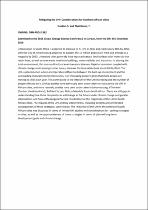JavaScript is disabled for your browser. Some features of this site may not work without it.
- ResearchSpace
- →
- Research Publications/Outputs
- →
- Conference Publications
- →
- View Item
| dc.contributor.author |
Naidoo, Sasha

|
|
| dc.contributor.author |
Thambiran, Tirusha

|
|
| dc.date.accessioned | 2017-11-06T12:55:06Z | |
| dc.date.available | 2017-11-06T12:55:06Z | |
| dc.date.issued | 2016-12 | |
| dc.identifier.citation | Naidoo, S. and Thambiran, T. 2016. Mitigating the UHI: Considerations for Southern African cities. Global Change Science Conference, 5-8 December 2016, Durban, South Africa | en_US |
| dc.identifier.uri | http://hdl.handle.net/10204/9735 | |
| dc.description | Paper presented at Global Change Science Conference, 5-8 December 2016, Durban, South Africa | en_US |
| dc.description.abstract | Urbanisation in South Africa is expected to increase to 71.3 % in 2030 and reach nearly 80% by 2050, with the City of Johannesburg projected to surpass the 10 million population mark and emerge as a megacity by 2030. Urbanised cities generally have replaced natural land surfaces with materials that retain heat, as well as have waste heat from buildings, motor vehicles and industries. In altering the local environment, this can result in local environmental stresses. Rapid urbanisation coupled with climate change could amongst other issues, increase the local urban heat island (UHI) effect. The UHI, a phenomenon where a temperature difference between the built-up environment and the surrounding (natural) environment exists, is of increasing concern given that more people are moving to cities each year. This contributes to the intensity of the UHI increasing and the number of people affected by it. Limited studies have previously been undertaken to characterise the UHI in African cities, and more recently, studies have been undertaken in Johannesburg, eThekwini (Durban, KwaZulu-Natal), Buffalo City and Nelson Mandela Bay in South Africa. There are still gaps in understanding how these temperatures will change in the future under climate change and greater urbanisation, and how anthropogenic factors could influence the magnitude of the UHI in South African cities. The impacts of the UHI and key interventions, including benefits and unintended consequences of these strategies, were shown. The relevance of the UHI in the context of South African cities was discussed in terms of limited UHI studies and considerations for cooling strategies in cities, as well as the appropriateness of these strategies in terms of planned long-term development goals and climate change. | en_US |
| dc.language.iso | en | en_US |
| dc.relation.ispartofseries | Worklist;19500 | |
| dc.subject | South African urbanisation | en_US |
| dc.subject | Climate change | en_US |
| dc.subject | Environmental stresses | en_US |
| dc.title | Mitigating the UHI: Considerations for Southern African cities | en_US |
| dc.type | Conference Presentation | en_US |
| dc.identifier.apacitation | Naidoo, S., & Thambiran, T. (2016). Mitigating the UHI: Considerations for Southern African cities. http://hdl.handle.net/10204/9735 | en_ZA |
| dc.identifier.chicagocitation | Naidoo, Sasha, and Tirusha Thambiran. "Mitigating the UHI: Considerations for Southern African cities." (2016): http://hdl.handle.net/10204/9735 | en_ZA |
| dc.identifier.vancouvercitation | Naidoo S, Thambiran T, Mitigating the UHI: Considerations for Southern African cities; 2016. http://hdl.handle.net/10204/9735 . | en_ZA |
| dc.identifier.ris | TY - Conference Presentation AU - Naidoo, Sasha AU - Thambiran, Tirusha AB - Urbanisation in South Africa is expected to increase to 71.3 % in 2030 and reach nearly 80% by 2050, with the City of Johannesburg projected to surpass the 10 million population mark and emerge as a megacity by 2030. Urbanised cities generally have replaced natural land surfaces with materials that retain heat, as well as have waste heat from buildings, motor vehicles and industries. In altering the local environment, this can result in local environmental stresses. Rapid urbanisation coupled with climate change could amongst other issues, increase the local urban heat island (UHI) effect. The UHI, a phenomenon where a temperature difference between the built-up environment and the surrounding (natural) environment exists, is of increasing concern given that more people are moving to cities each year. This contributes to the intensity of the UHI increasing and the number of people affected by it. Limited studies have previously been undertaken to characterise the UHI in African cities, and more recently, studies have been undertaken in Johannesburg, eThekwini (Durban, KwaZulu-Natal), Buffalo City and Nelson Mandela Bay in South Africa. There are still gaps in understanding how these temperatures will change in the future under climate change and greater urbanisation, and how anthropogenic factors could influence the magnitude of the UHI in South African cities. The impacts of the UHI and key interventions, including benefits and unintended consequences of these strategies, were shown. The relevance of the UHI in the context of South African cities was discussed in terms of limited UHI studies and considerations for cooling strategies in cities, as well as the appropriateness of these strategies in terms of planned long-term development goals and climate change. DA - 2016-12 DB - ResearchSpace DP - CSIR KW - South African urbanisation KW - Climate change KW - Environmental stresses LK - https://researchspace.csir.co.za PY - 2016 T1 - Mitigating the UHI: Considerations for Southern African cities TI - Mitigating the UHI: Considerations for Southern African cities UR - http://hdl.handle.net/10204/9735 ER - | en_ZA |






